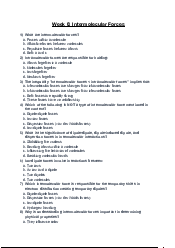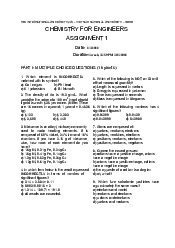









Preview text:
25/5/2020
Review Test Submission: Quiz 2 - Into the matter – ... THAO PHAM VAN IU Cours 4 e 4 s H
Assignments Review Test Submission: Quiz 2 - Into the matter Ch
Review Test Submission: Quiz 2 - Into the matter User THAO PHAM VAN Course
Chemistry for Engineers_S2_2019-20_G02 Test Quiz 2 - Into the matter Started 3/23/20 11:18 PM Submitted 3/23/20 11:27 PM Due Date 3/27/20 11:59 PM Status Completed Attempt Score 280 out of 280 points Time Elapsed 9 minutes out of 1 hour
Results Displayed All Answers, Submitted Answers, Correct Answers Question 1 10 out of 10 points The characteristics of gas are Selected A. Answer:
Gas have properties of maintaining the shape and volume which belong to the container, they
also have the easy compressibility and particles’ floating. Answers: A.
Gas have properties of maintaining the shape and volume which belong to the container, they
also have the easy compressibility and particles’ floating. B.
Gas have properties of maintaining the shape but not the volume of its container, they also
have difficult compressibility and particles’ floating. C.
Gas is not easily to be compressed, their volume is maintained, flow difficultly and become the shape of its container. D.
Gas is not easily compressed, their volume is not maintained, flow easily and become the shape of its container. Question 2 10 out of 10 points What is a mixture? Selected D. A & C are correct Answer:
https://blackboard.hcmiu.edu.vn/webapps/assessment/review/review.jsp?attempt_id=_258043_1&course_id=_12268_1&content_id=_120033_1&out… 1/10 25/5/2020
Review Test Submission: Quiz 2 - Into the matter – ... Answers: A.
Two or more substances that are physically mixed together but not chemically combined
B. Two or more substances that are physically mixed together and chemically combined
C. A mixture can be seperated into substances by physical process(es) D. A & C are correct Question 3 10 out of 10 points
Calculate the heat absorbed by 3.5 g of water to raise its temperature from 10.0°C to 99.0°C (at constant
pressure). The specific heat of water is 4.18 J/(g.°C). Note: pay attention on the number of significant figures Selected Answer: A. 1.3 x 103 J Answers: A. 1.3 x 103 J B. 6.5 x 102 J C. 1302.07 J D. 4.2 J Question 4 10 out of 10 points
Which of the following is about specific heat capacity? Selected Answer:
B. Specific heat capacity of water (liquid) is 4.184 J/(g.°C) Answers:
A. Specific heat capacity of 10 g of water (liquid) is 41.84 J/(g.°C)
B. Specific heat capacity of water (liquid) is 4.184 J/(g.°C)
C. Specific heat capacity of water (liquid) is 2.03 J/(g.°C)
D. Specific heat capacity of 2 g of water (liquid) is 8.368 J/(g.°C) Question 5 10 out of 10 points
How many types of kinetic energy are there? Selected Answer: B. 3 Answers: A. 2 B. 3 C. 4 D. 5 Question 6 10 out of 10 points
https://blackboard.hcmiu.edu.vn/webapps/assessment/review/review.jsp?attempt_id=_258043_1&course_id=_12268_1&content_id=_120033_1&out… 2/10 25/5/2020
Review Test Submission: Quiz 2 - Into the matter – ...
Which one is conserved, mass or energy? Selected Answer: C. Both mass and energy Answers: A. Mass B. Energy C. Both mass and energy D. None of them Question 7 10 out of 10 points What is physical property? Selected B. Answer:
Physical properties are the characteristics of matter that can be changed without changing its
composition. They are directly observable Answers: A.
Physical properties are the characteristics of matter that can be changed without changing its
composition. They are indirectly observable B.
Physical properties are the characteristics of matter that can be changed without changing its
composition. They are directly observable C.
Physical properties are the characteristics of matter that can be changed with changing its
composition. They are directly observable D.
Physical properties are the characteristics of matter that can be changed with changing its
composition. They are indirectly observable Question 8 10 out of 10 points What is matter? Selected Answer:
A. Things that takes space and has its mass is matter. Answers:
A. Things that takes space and has its mass is matter.
B. Everything having their own mass is matter. C. Nothing is called matter.
D. None of these answers above. Question 9 10 out of 10 points
How many states of matter are there? (including plasma) Selected Answer: B. 4 states. Answers: A. 3 states.
https://blackboard.hcmiu.edu.vn/webapps/assessment/review/review.jsp?attempt_id=_258043_1&course_id=_12268_1&content_id=_120033_1&out… 3/10 25/5/2020
Review Test Submission: Quiz 2 - Into the matter – ... B. 4 states. C. A, B are not correct. A, C are correct. D. Question 10 10 out of 10 points
What is the example of kinetic energy? Selected Answer: A. All of them Answers: A. All of them B. A bullet fired from a gun C. Spinning flywheels D. An airplane in flight Question 11 10 out of 10 points What is exothermic reaction? Selected D. Answer:
In an exothermic reaction, the heat is released from system. The chemical potential energy of
reactants is higher than one of products. Answers: A.
In an exothermic reaction, the heat is absorbed from surrounding. The chemical potential
energy of reactants is lower than one of products. B.
In an exothermic reaction, the heat is absorbed from surrounding. The chemical potential
energy of reactants is higher than one of products. C.
In an exothermic reaction, the heat is released from system. The chemical potential energy of
reactants is lower than one of products. D.
In an exothermic reaction, the heat is released from system. The chemical potential energy of
reactants is higher than one of products. Question 12 10 out of 10 points
Which factors affect heat loss/gain of a reaction? Selected Answer:
B. Mass, temperature, specific heat capacity Answers: A. Mass, height
B. Mass, temperature, specific heat capacity C. Mass, temperature, velocity D. Mass, velocity
https://blackboard.hcmiu.edu.vn/webapps/assessment/review/review.jsp?attempt_id=_258043_1&course_id=_12268_1&content_id=_120033_1&out… 4/10 25/5/2020
Review Test Submission: Quiz 2 - Into the matter – ... Question 13 10 out of 10 points
What is the process that water vapor transforms into ice on the window in winter? Selected Answer: A. Deposition Answers: A. Deposition B. Freezing C. Condensation D. Recombination Question 14 10 out of 10 points
What is the example of potential energy? Selected B. All of them Answer: Answers:
A. An energy of interaction inside O molecule 2 B. All of them
C. Tree branches high up in a tree have potential energy because they can fall to the ground. D.
A rock sitting at the edge of a cliff has potential energy. If the rock falls, the potential energy
will be converted to kinetic energy. Question 15 10 out of 10 points What is endothermic reaction? Selected C. Answer:
In an endothermic reaction, the heat is absorbed from surrounding. The chemical potential
energy of reactants is lower than one of products. Answers: A.
In an endothermic reaction, the heat is absorbed from system. The chemical potential energy
of reactants is lower than one of products. B.
In an endothermic reaction, the heat is absorbed from surrounding. The chemical potential
energy of reactants is higher than one of products. C.
In an endothermic reaction, the heat is absorbed from surrounding. The chemical potential
energy of reactants is lower than one of products. D.
In an endothermic reaction, the heat is absorbed from system. The chemical potential energy
of reactants is higher than one of products.
https://blackboard.hcmiu.edu.vn/webapps/assessment/review/review.jsp?attempt_id=_258043_1&course_id=_12268_1&content_id=_120033_1&out… 5/10 25/5/2020
Review Test Submission: Quiz 2 - Into the matter – ... Question 16 10 out of 10 points
What is the process from water (liquid) to steam Selected Answer: Vaporization A. Answers: Vaporization A. Recombination B. Condensation C. Sublimination D. Question 17 10 out of 10 points
What is the formula to calculate the heat loss/gain in a reaction? Selected Answer: B. E = mC(∆T) Answers: A. E = (mv2 )/2 B. E = mC(∆T) C. E = mc2 D. E = mgh Question 18 10 out of 10 points
The characteristics of solid are: Selected A. Answer:
They are difficult to be pressed, volume and shape are stable, and theirs particles do not float easily Answers: A.
They are difficult to be pressed, volume and shape are stable, and theirs particles do not float easily
B. They have metallic luster, good plasticity, conductor and heat conductivity. C. A and B are both correct. D. A and B are not correct. Question 19 10 out of 10 points
What is the process from steam to water (liquid)
https://blackboard.hcmiu.edu.vn/webapps/assessment/review/review.jsp?attempt_id=_258043_1&course_id=_12268_1&content_id=_120033_1&out… 6/10 25/5/2020
Review Test Submission: Quiz 2 - Into the matter – ... Selected Answer: C. Condensation Answers: A. Vaporization B. Recombination C. Condensation D. Sublimination Question 20 10 out of 10 points
What is energy? How many types of energy are there? Selected B. Answer:
Energy does not have mass, volume but is able to do work or generate heat. 2 types. Answers: A.
Energy does not have mass, volume and the capacity to do work or generate heat. 3 types. B.
Energy does not have mass, volume but is able to do work or generate heat. 2 types.
C. Energy has mass, volume and the capacity to do work or generate heat. 2 types.
D. Energy has mass, volume and is not able to do work or generate heat. 3 types. Question 21 10 out of 10 points
Among those pure substances C, H O, O , CO , N , Na, which one are componds? And which one are 2 2 2 2 element? Selected Answer:
C. Compound: H O, CO ; Element: C, O , N , Na 2 2 2 2 Answers:
A. Compound: N , CO ; Element: C, O , Na, H O 2 2 2 2
B. Compound: H O, O ; Element: C, CO , N ,Na 2 2 2 2
C. Compound: H O, CO ; Element: C, O , N , Na 2 2 2 2
D. Compound: CO ; Element: C, O , Na, H O, N 2 2 2 2 Question 22 10 out of 10 points
Which of the following is about heat capacity? Selected Answer: D. A & C are correct Answers:
A. Heat capacity of 2 g of water (liquid) is 8.368 J/(g.°C)
B. Heat capacity of water (liquid) is 4.184 J/(g.°C)
C. Heat capacity of 10 g of water (liquid) is 41.84 J/(g.°C)
https://blackboard.hcmiu.edu.vn/webapps/assessment/review/review.jsp?attempt_id=_258043_1&course_id=_12268_1&content_id=_120033_1&out… 7/10 25/5/2020
Review Test Submission: Quiz 2 - Into the matter – ... D. A & C are correct Question 23 10 out of 10 points
The characteristics of liquid are Selected B. Answer:
They are not easily compressed, their volume is maintained, flow easily and become the shape of its container. Answers: A.
They are not easily compressed, their volume is not maintained, flow easily and become the shape of its container. B.
They are not easily compressed, their volume is maintained, flow easily and become the shape of its container. C.
They are easily to be compressed, their volume is maintained, flow quite easily and
become the shape of its container. D.
They are not easily to be compressed, their volume is maintained, flow difficultly and
become the shape of its container Question 24 10 out of 10 points
What is chemical potential energy? Selected Answer:
B. Chemical potential energy is due to chemical interaction Answers:
A. Chemical potential energy is due to matter interaction
B. Chemical potential energy is due to chemical interaction
C. Chemical potential energy is due to physical interaction
D. Chemical potential energy is due to chemical kinetic interaction Question 25 10 out of 10 points
https://blackboard.hcmiu.edu.vn/webapps/assessment/review/review.jsp?attempt_id=_258043_1&course_id=_12268_1&content_id=_120033_1&out… 8/10 25/5/2020
Review Test Submission: Quiz 2 - Into the matter – ...
Q10.1. Atoms of an element: [10.1]
Q10.2. Molecules of a compound: [10.2]
Q10.3. Molecules of an element: [10.3]
Q10.4. Mixture of elements and a compound: [10.4] Specified Answer for: 10.1 A Specified Answer for: 10.2 C Specified Answer for: 10.3 B Specified Answer for: 10.4 D
Correct Answers for: 10.1 Evaluation Method Correct Answer Case Sensitivity A
Correct Answers for: 10.2 Evaluation Method Correct Answer Case Sensitivity C
Correct Answers for: 10.3 Evaluation Method Correct Answer Case Sensitivity B
Correct Answers for: 10.4 Evaluation Method Correct Answer Case Sensitivity D Question 26 10 out of 10 points
What is the process from dry ice (solid) to CO (gas) 2 Selected Answer: Sublimination A. Answers: Sublimination A. Recombination B. Vaporization C. Condensation D. Question 27 10 out of 10 points
According to table “Specific heat capacities for common subtance” in slide 38 of Chapter 3, Aluminum,
carbon (gra), water (l), ethanol, which one should be used as cooling agent? Why?
https://blackboard.hcmiu.edu.vn/webapps/assessment/review/review.jsp?attempt_id=_258043_1&course_id=_12268_1&content_id=_120033_1&out… 9/10 25/5/2020
Review Test Submission: Quiz 2 - Into the matter – ... Selected B. Answer:
Water (l) because with the same amount of substance, water needs the most amount of heat to heat it up Answers:
A. Aluminum because alunimun absorbs a lot of heat for a relatively small mass B.
Water (l) because with the same amount of substance, water needs the most amount of heat to heat it up
C. Ethanol because alunimun absorbs a lot of heat for a relatively small mass D.
Carbon because with the same amount of substance, carbon needs the most amount of heat to heat it up Question 28 10 out of 10 points What is chemical property? Selected B. Answer:
Chemical properties are the characteristics that determine how the composition of matter changes
as a result of contact with other matter or the influence of energy. They describe the behavior of matter Answers: A.
Chemical properties are the characteristics that determine how the composition of matter changes
as a result of contact with other matter or the influence of heat. They describe the behavior of matter B.
Chemical properties are the characteristics that determine how the composition of matter changes
as a result of contact with other matter or the influence of energy. They describe the behavior of matter C.
Chemical properties are the characteristics that determine how the composition of matter changes
as a result of contact with other matter or the influence of reactants. They describe the behavior of matter D.
Chemical properties are the characteristics that determine how the structure of matter changes as
a result of contact with other matter or the influence of energy. They describe the behavior of matter
Monday, May 25, 2020 8:45:17 PM ICT ← OK O
https://blackboard.hcmiu.edu.vn/webapps/assessment/review/review.jsp?attempt_id=_258043_1&course_id=_12268_1&content_id=_120033_1&ou… 10/10




